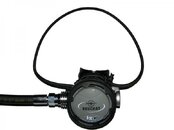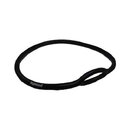Bet you a beer you can't pull my reg out of my bungee necklace without breaking the cord or the mouthpiece..!

If you tie the loop tight with the bungee stretched, and then fix the knots in the standard fashion (melt the ends with lighter and/or use crazy glue), it really won't slip out. Zip tie not absolutely necessary, although some people do run a zip tie around the cord below the knots for extra security. Now, whether or not this is a good idea seems to be somewhat controversial, with reasonable arguments on both sides. I don't have the experience to make a strong case for my approach, but overall I am happiest knowing that the backup second stage is going to be in easy reach when I need it (since I won't be donating this one).
Maybe someday I'll have a chance to take you up on that bet!

I am not sure how you have tied your knots, but I believe double fisherman's knots would be the standard way, at least that's how I did it. This allows you to pull the opening for the reg tight. I also have mine cinched very tight, so even if the reg hose was to snag (which would be difficult) the reg would not pull out unless you were scootering, it still comes out with a sharp tug if neccessary, and I cannot see, for the diving I'm doing, changing this setup.
Right, that's why you want it right next to your mouth. I mean, I certainly COULD break the system, and in a real emergency I could cut the bungee with one of my cutting tools (or just take it over my head), but wouldn't you want it where you are most likely to need it? I guess there are entanglement scenarios that would make a breakaway system helpful (the regulator, not the bungee loop itself), but I would rather have the reg where I am most likely to be needing it. Sort of like the examples of people who were killed in car accidents due to seat belt strangulation, or were saved when they were thrown clear. Statistically, you are still more likely to be saved by your seat belt than killed, examples to the contrary notwithstanding.
We are certainly in agreement that a bungied necklace is a very good if not preferable way of keeping your regulator, secured and easily accessible, no matter if you dive backmount or sidemount, recreational or tec.
You may be right, I'm not a technical diver, but I do dive doubles with a long hose and a bungeed necklace for my backup second stage. I don't know anything about sidemount, so if those divers need breakaway necklaces, then they should use them. I'm not sure why you would need to take the second regulator out of your necklace for the OOA drill you describe, if you are donating the primary and then breathing from the secondary.
In sidemount you do not have a primary and secondary regulator, both regs are "primary" as they are is only 1 2nd stage attached to each 1st stage for each tank. Why would you donate the regulator from the necklace? Because as a technical diver you are always donating the reg in your mouth (IMHO should be in recreational as well, although it can be taught both ways), and that may be the bungied short hose. You know that the reg is working and delivering gas, and that gas is safe to be breathing at your current depth. Also the ooa diver may be going for the most obvious source of working gas which is the reg in your mouth. Practicing this way (donate the reg in your mouth) also prepares you to have reg out of your mouth for any number of reasons including ooa situations but also maybe some moron just kicked the reg out of your mouth, or you snagged your hose and pulled the reg out, or any other circumstance that you can imagine. This IS different than backmount doubles (which I assume you are diving), where you are always breathing from your long hose and that is what gets donated, allowing you to go to your bungied backup. In sidemount, if you donate the short hose because that is what you are breathing, you would then switch the reciever to the long hose once both divers have gas and control of the situation.
I think that we may be confusing the need for a releasable backup second stage with the classic OW approach of donating your "octopus", and the need for a more fixed second stage if you are donating your primary. So as far as the OP is concerned, a breakaway, deployable octopus holding solution would be needed. But maybe this discussion will show her the advantages of a long hose on the donated primary, even for new divers. For example, in the OP's scenario, having a 7 (or 5) foot hose would have been helpful, as I mentioned above...
I am not confusing the OW releasable 2nd, but I think it more comes from your lack of familiarity with sidemount and potential issues that may arrise and how gear needs to be configured differently to deal with those issues. That said, I think the discussion is a good one, as SM becomes more common, you may one day find your self buddied with a SM diver and knowing what may differences you may be dealing with in an emergency can only be a good thing. A permanently attached bungied backup works for you in BM, and I'm not saying that it will kill you by any streach, but is not the solution for everyone. A releasable solution also will not kill you. I agree as I stated above that there are advantages to even recreational divers learning to donate the reg from their mouth, long hoses, I think need either training or a mentor to show you how not to create more issues mainly around entanglement, but even for recreational diving, in some circumstances can certainly have some advantages.
Have fun and dive safe







